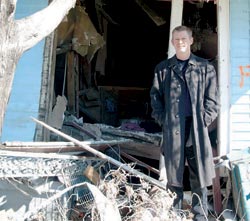
Dr. Stephen Sherry stands in front of a house destroyed by Hurricane Katrina in the devastated Ward Nine of New Orleans. Note the orange markings on the right side of the photo that indicate the house has been searched for human remains.
Photo courtesy of Dr. Stephen Sherry
National Library of Medicine Scientist Helps Identify Disaster Victims, Eases Grieving
Dr. Stephen Sherry will never forget meeting in the New York City mayor's office a couple of years after 9/11 with a woman whose husband had died in the tragedy. Still distraught, she kept asking how she could be certain that his remains had really been discovered.
"The State medical examiner pulled up our software and there on the screen were the matching lines and curves of the identifying DNA profile. Somehow it made sense to her and she was greatly relieved," Sherry recalls.
A physical anthropologist who'd done his Ph.D. fieldwork examining the DNA of ethnic and kinship groups, Sherry had been tapped after 9/11 to lead a team from NLM's National Center for Biotechnology Information (NCBI) to devise software that could quickly verify individual DNA profiles despite their being damaged by environmental, bacterial or other contaminants, conditions that make accurate genetic "reading" difficult.
DNA Testing
Composed of two long "strings" of intertwined building blocks—the nucleotides adenine, thymine, guanine and cytosine—DNA (deoxyribonucleic acid) is life's chemical instruction manual, governing how cells grow, divide, live and die. The patterns in which the strings are arranged are unique to every person, and thus make up an individual's genetic code, or DNA "fingerprint."
After mass disasters like 9/11 or Hurricane Katrina, Sherry believes it is very important to identify the dead as quickly as possible for both forensic and humanitarian reasons. "Losing a loved-one without tangible remains for the funeral can thwart the grieving process for family and friends, and it's difficult for society to return to normal if the dead cannot be identified." "Except for slight variations in patterns between ethnic groups, races and genders, DNA is the same in most people." Sherry points out. "The greatest similarities are to be found among family members."
Working with Damaged DNA
In DNA analysis of families, for example, cells are swabbed from inside a parent's cheek then scanned by computer for the DNA genetic markers or identifiers that might prove relationship, such as that between father and child. Typically, this type of testing uses pristine, high-quality DNA samples.
With 9/11 and later with Hurricane Katrina, Sherry and his team had no such advantage. There were virtually no intact bodies from 9/11, most remains having been fragmented by falling debris or burned to the point of charcoal.
"It was like looking at smudged fingerprints; you couldn't be sure they belonged to a certain individual," Sherry says. "We had to develop software that would work with the lab results from badly damaged human remains, to see if a match could be made between a living relative and the deceased, or between the dead and, say, the hair from a hair brush."
Ancient Egypt and Modern Analysis
So he and his team developed OSIRIS, for Open Source Independent Review and Interpretation System. Named after the Egyptian god of the underworld, OSIRIS's job is to make educated guesses—assessments—about an individual's genetic markers. Being able to make accurate assessments is the cornerstone of successful DNA matching. OSIRIS is able to analyze 10,000 DNA samples in two minutes (whereas an analyst takes a whole day just to complete 14 samples by hand).
"Think of OSIRIS as a code breaker, able to take the mystery out of a mass of data and put a name on human remains," urges Sherry. Because it can evaluate the results from other DNA sampling software, he says OSIRIS offers a kind of "second opinion" in the world of forensic analysis.
"Steve and his team did a tremendous job in developing OSIRIS to meet the immediate need of victim identification," says NCBI Director David Lipman, M.D. "Their work also has important applications in disease research, as well as other forensic uses."
Katrina Analysis Difficult, Poignant…
Sherry found identifying the dead from Hurricane Katrina particularly poignant because he'd done his post-doctoral studies in New Orleans. Unlike in 9/11, most personal effects—hair or tooth brushes, razors, or even letters that could yield DNA traces that could specifically link victim to identity—had vanished in Katrina's wake. Gone, too, were the medical and dental records traditionally used to establish identity.
"A team under supervision of the Louisiana State Police tested the OSIRIS software, but their task was complicated because the kin of many of the dead had scattered to other cities. Communication between family members was difficult, as was providing DNA samples."
To facilitate the analysis, the National Human Genome Research Institute trained several groups of student genetic counselors from Sarah Lawrence College to help track down the far-flung families and gather the necessary DNA.
Reflecting on the broader implications of his software, Sherry says, "I think identifying the dead, no matter how difficult or expensive, is absolutely necessary for the conduct of a civilized society."
Judith Folkenberg is a staff writer at the National Library of Medicine.
